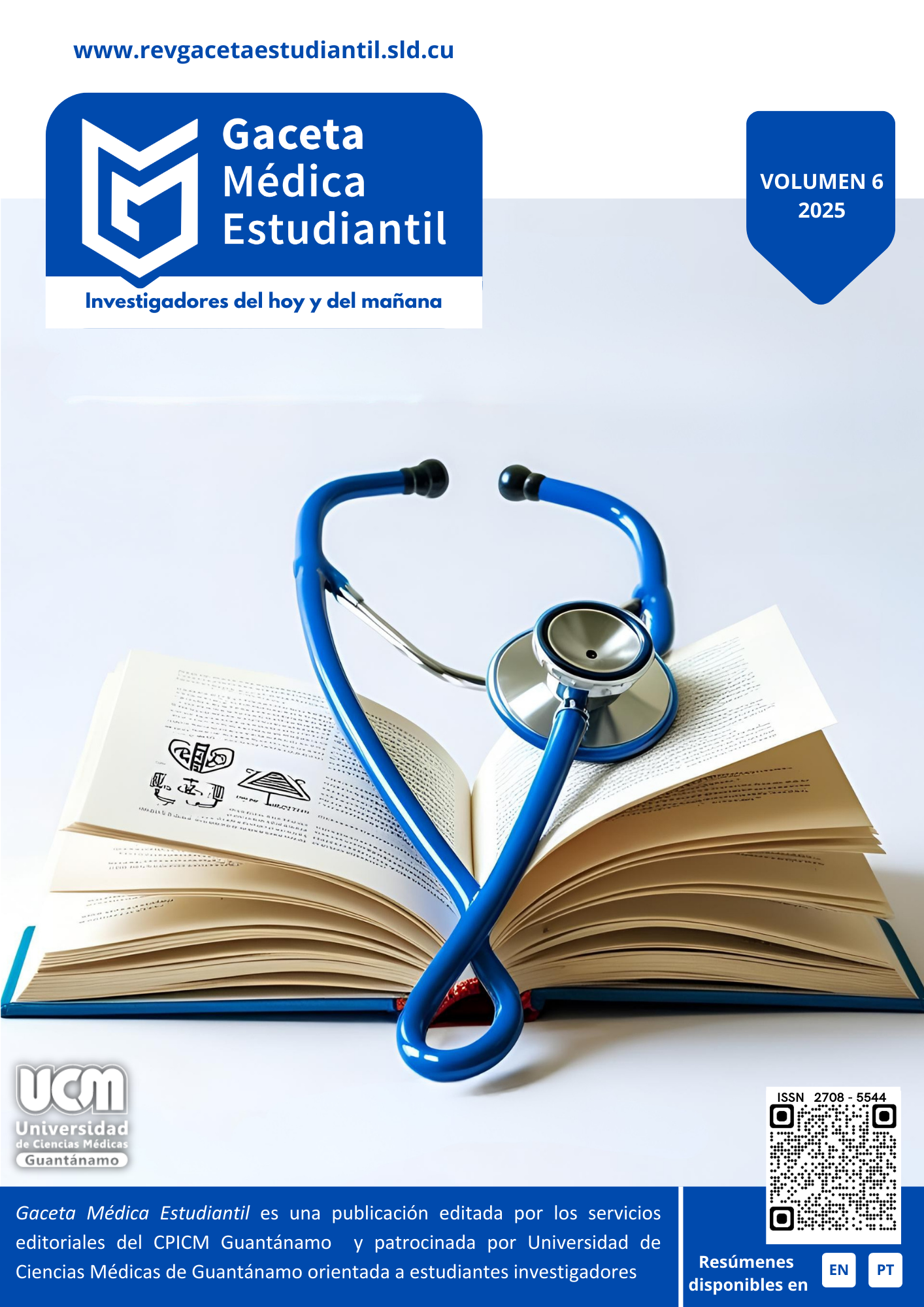Prognostic factors for mortality in patients postoperatively with acute occlusive abdomen
Keywords:
mortality, postoperative patients, intestinal obstruction, complicationsAbstract
Introduction: Surgical etiology is a common reason for admission to the intensive care unit. Objective: To determine the behavior of prognostic factors for mortality in postoperative patients with acute abdominal occlusion admitted to the intensive care unit of Dr. Agostinho Neto General Hospital between 2022 and 2023. Method: A descriptive, retrospective, and cross-sectional study was conducted among patients discharged from the intensive care unit (n = 56) with a postoperative diagnosis of intestinal occlusion. The discharge status, age, sex, comorbidity, complications, organ dysfunction, and nutritional status were analyzed. The odds ratio (OR) was calculated for each variable studied. Results: All selected variables were independent risk factors for mortality in postoperative patients with intestinal obstruction, but those with a higher probability of death were complications with ARDS (OR: 7.1; 95% CI: 5.1–8.4) and multiorgan failure (OR: 6.3; 95% CI: 3.9–8.6). An APACHE II score greater than 20 points increased the likelihood of death sevenfold (OR: 6.7; 95% CI: 3.9–8.7); being older than 60 years increased this likelihood fivefold (OR: 5.1; 95% CI: 2.1–8.4). Conclusions: Age greater than 60 years, complications with ARDS and multiorgan failure, and an APCHE II score greater than 20 points were causal factors explaining mortality.
Downloads
References
1. Hernández Ruíz A, Vinent Llorente JA, Delgado Fernández RI, Castillo Cuell JJ. Factores que influyen en la mortalidad en los pacientes graves con cirugía abdominal. Revista Cubana de Cirugía, Vol. 53, No. 2 (2016)(visto abril 2021) disponible en : http://revcirugia.sld.cu/index.php/cir/rt/printerF
2. Martín Bourricaudy N, Rodríguez Delgado R, Rodríguez Rodríguez I, Sosa Palacios O, Reyes de la Paz A. Factores de riesgo relacionados con las relaparotomías después de cirugía gastrointestinal. Rev Cubana Med Mil. 2017 [citado 16 abril 2021];37(1). Disponible en: http://scielo.sld.cu/scielo.php?script=sci_arttext&pid=S0138-65572017000100005&lng=es
3. Peacock O, Bassett MG, Kuryba A, Walker K, Davies E, Anderson I, et al. Thirty-day mortality in patients undergoing laparotomy for small bowel obstruction. British Journal of Surgery. 2018; 105(8): p. 1006-1013.
4. Dare AJ, Ng-Kamstra JS, Patra J, Fu SH, Rodriguez PS, Hsiao M, Jotkar RM, Thakur JS, Sheth J, Jha P. Deaths from acute abdominal conditions and geographical access to surgical care in India: a nationally representative spatial analysis. The Lancet Global Health. 2015 Oct 1;3(10):e646-53.
5. Domínguez GE. Factores predictivos de mortalidad en la oclusión intestinal por bridas. Revista Repertorio De Medicina Y Cirugía. 2016; 25(3): p. 163-167. Valencia F, Morales M, Rinchon C, Navarro E, Bautista C, De la Cerda L, Rea L, López C. El íleo biliar: una revisión de la literatura médica. Rev Gastroenterol [Internet] 2016 [consultado 12 de abril de 2021]; 85 (1): p.1-7 Disponible en sección nacional de registros médicos y estadísticas de salud. Anuario Estadístico de Salud, 2011. La Habana: MINSAP; 2012.
6. Ministerio de Salud Pública, Dirección nacional de registros médicos y estadísticas de salud. Anuario Estadístico de Salud, 2012. La Habana: MINSAP; 2013.
7. Shaff MI, Tarr R, León Portain C, James EA. Tomografía computarizada y Resonancia magnética en el cuadro abdominal agudo. ClínQuirNort. 1988;2:253-76.
8. Durán Pérez J, Rodríguez García LC, Alcalá-CerraG .Mortalidad e infecciones nosocomiales en dos unidades de cuidados intensivos de la ciudad de Barranquilla (Colombia) Salud Uninorte, vol. 24, núm. 1, 2017, pp. 74-86 (INTERNET)(visto abril 2021)disponible en : http://www.redalyc.org/articulo.oa?id=81724109
9. Llera Domínguez G. Infecciones intra-abdominales. Evolución no satisfactoria. Facultad de Medicina Hospital General Docente Calixto García. La Habana; 2007
10. García Vega ME. Reintervención abdominal en una unidad de cuidados intermedios quirúrgicos. Rev Cubana MedMilit. 2005;34(4):89-94.
11. Penner R, Mujumdar S. Diagnostic approachto abdominal pain in adult.Fletcher R, Sokol N, editors (actualizado abril 2016; revisado abril 2021 )disponible en: www.uptodate.com
12. Quintero Infante A, Pérez Assef A, Díaz Mayo J. Influencia de la albúmina sérica en la evolución de la cirugía abdominal en una unidad de cuidados intensivos de un hospital provincial de la Habana. Rev Cuba Aliment y Nutr. INTERNET 2018 [citado 2022 Feb 25]; 28(2):356–69. Disponible en: https://revalnutricion.sld.cu/rcan/article/view
13. Zhou G, Zhu F, An Y, Qin L, Lv J, Zhao X, et al. Prolonged preoperative fasting and prognosis in critically ill gastrointestinal surgery patients. Asia Pac J ClinNutr. INTERNET 2022, [citado 2022 Feb 25];;29(1):41–7 disponible en: https://pubmed.ncbi.nlm.nih.gov
14. Pimenta GP, De Aguilar-Nascimento JE. Prolonged preoperative fastingin elective surgical patients: Why should we reduce it? Nutr Clin Pract. INTERNET 2014, [citado 2022 Feb 25];;29(1):22–8 disponible en: https://pubmed.ncbi.nlm.nih.gov
Downloads
Published
How to Cite
Issue
Section
License
Copyright (c) 2025 Rosibery Samón-Marrero , Yalit Perez-Roblejo , José González-Molina , Yanila Savon-Robert , Yanet Blanco-Robles

This work is licensed under a Creative Commons Attribution-NonCommercial 4.0 International License.
The Gaceta Médica Estudiantil magazine provides immediate Open Access to its content. It is published under a Creative Commons Attribution-NonCommercial 4.0 International (CC BY-NC) license, which allows sharing (copying and redistributing the material in any medium or format) and adapting (remixing, transforming, and building upon the material), under the terms of acknowledge authorship and not make commercial use of the materials.












